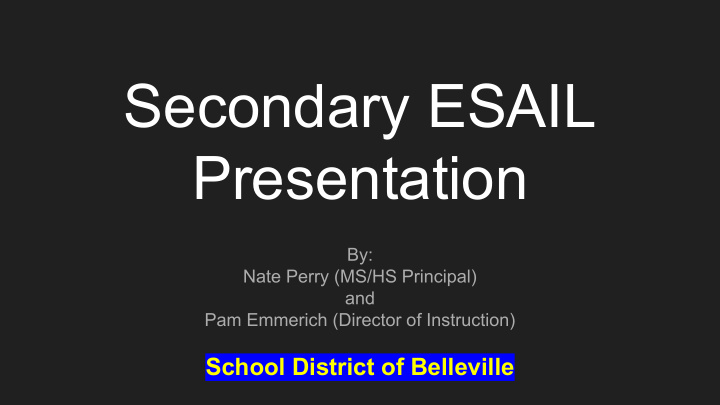



Secondary ESAIL Presentation By: Nate Perry (MS/HS Principal) and Pam Emmerich (Director of Instruction) School District of Belleville
Purpose of Presentation: To create an understanding of how the ESAIL can be used at the secondary level to assess professional learning and align with school improvement plans.
Table Introduction: Name Title/Role in District Prior Knowledge/Use of ESAIL in your District
What is the ESAIL? E nvironmental S cale for A ssessing I mplementation L evels
Environmental Scale for Assessing Implementation Levels ● Distribute ESAIL and allow time to review.
Multi-Purpose Tool 1. Pre-Assessment... ...to determine a school's readiness for implementing CLM. 2. Periodic Assessment... ...to study a school's growth over time on one or more literacy criteria.
Multi-Purpose Tool (cont’d) 3. Post-Assessment... ...to measure a school's improvement over the academic year. 4. Guide and Monitor... ...school-wide efforts, including professional development in particular areas.
10 Criterion in an ESAIL Criterion 1: Creates a Literate Environment Criterion 2: Organizes the Classroom Criterion 3: Uses Data to Inform Instruction and to Provide Research Based Interventions Criterion 4: Uses a Differentiated Approach to Learning Criterion 5: Uses Assessment Wall for School-wide Progress Monitoring
10 Criterion in an ESAIL (Cont’d) Criterion 6: Uses Literacy Coaches to Support Teacher Knowledge and Reflective Practices Criterion 7: Builds Collaborative Learning Communities Criterion 8: Creates and Uses School Plans for Promoting Systemic Change Criterion 9: Uses Technology for Effective Communication Criterion 10: Advocates and Spotlights a School’s Literacy Program
ESAIL Logistics ● SSched ● Setting the Stage with Staff : Descriptive Ideas ● Schedule ● Time ● Materials
ESAIL Logistics - Scoring M = Meeting-Was there a preponderance of observable evidence in each grade level band to warrant an M? A = Approaching-There was some observable evidence but not observed in all classes. B = Below-Evidence not observed in most classrooms.
Belleville Middle and High School Professional Development for the 2015-16 School Year 1. Focus on instructional practices 2. Centered around The Fundamental Five by Cain and Laird ○ Frame the Lesson ○ Work in the Power Zone ○ Frequent, Small Group, Purposeful Talk about the Learning ○ Recognize and Reinforce ○ Write Critically 3. Paired six sessions with Michelle Amend on critical writing
Continued Professional Development for the 2016-17 School Year Michelle Amend had eight more sessions with our staff this past year, with a continued focus on critical writing: Session 1 Session 3 Session 2 Session 6
Belleville Middle and High School ESAILs 2015-17 April 27, 2016: End of year ESAIL (2015-16) ● Agenda ● Results October 24, 2016 December 7, 2016 March 6, 2017 April 26, 2017
Evolution of ESAIL Practices - Adapting to fit our needs Full ESAIL at the end of the 2015-2016 School year
Evolution of ESAIL Practices - Adapting to fit our needs ESAIL around school improvement plan goals in the fall of the 2016-17 school year
Evolution of ESAIL Practices - Adapting to fit our needs Targeted ESAIL around department goals in the winter of the 2016-17 school year
Partner Discussions ● How could or do you adapt the ESAIL to fit your district’s needs? *Keep the full ESAIL for the end-of-the-year comparison/growth!
Calibration 1. Calibration was built into the schedule. 2. Time was also allotted at the end of the each ESAIL to debrief. 3. The participants tried to reach consensus on scores, particularly if scores were “off” by more than one level.
Sharing Findings with Staff Review of principals expectations on 12-12-16.
Sharing Findings with Staff Discussion on reflective practice on 5-8-17.
SIP Goal Planning 2016-17 Belleville Secondary SIP Goals
Leveraging Literacy Leadership (L3) 2017-18 Belleville Secondary Goal Setting
ESAIL and End of the Year Report ● Potential Information to Include: Belleville End of Year Report/ESAIL
Lessons Learned ● Organize summary of findings by grade bands (middle school/high school) rather than by grades/classroom to avoid micro analysis of teachers. ● Share explicitly with staff that the purpose is to identify patterns and trends, not evaluative, not about individual classrooms. ● Hold staff accountable only for what they have learned. ● Have more than three people for best calibration. ● ● ●
Lessons Learned 1. Be explicit with your staff regarding your expectations. Eg. digital vs. paper logs 2. Continue walkthroughs outside of the ESAIL. 3. Know what you should be seeing: look-fors. 4. Remember that it is all about continuous growth. 5. Sometimes change is slow, and there are setbacks.
Partner Discussions 1. What are your takeaways from this session? 2. What are your district’s next steps with the ESAIL?
To Copy: -Agenda April 2017 MS - HS ESAIL Walkthrough -Sussess Critera Belleville ESAIL 2016-2017
Recommend
More recommend